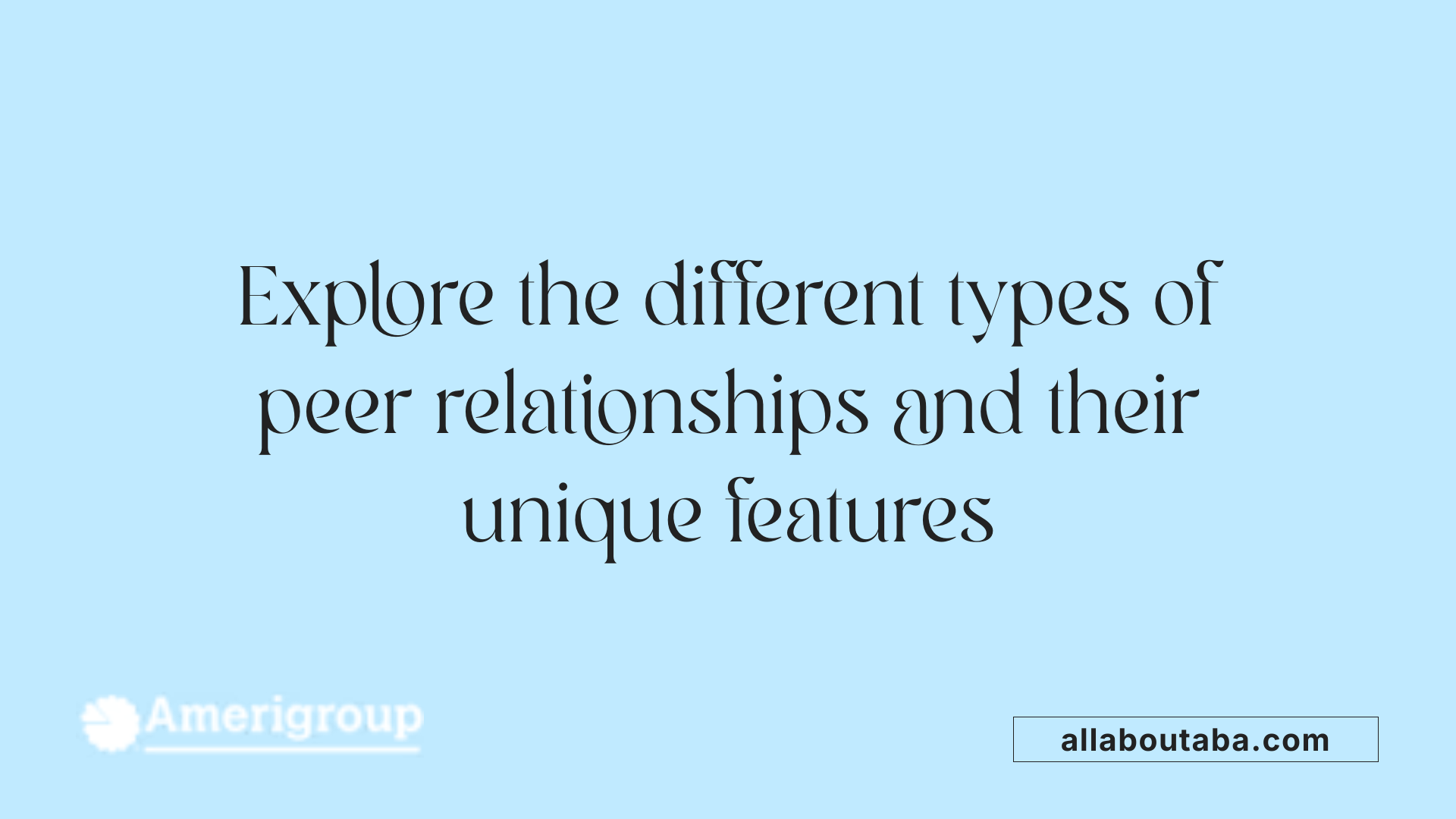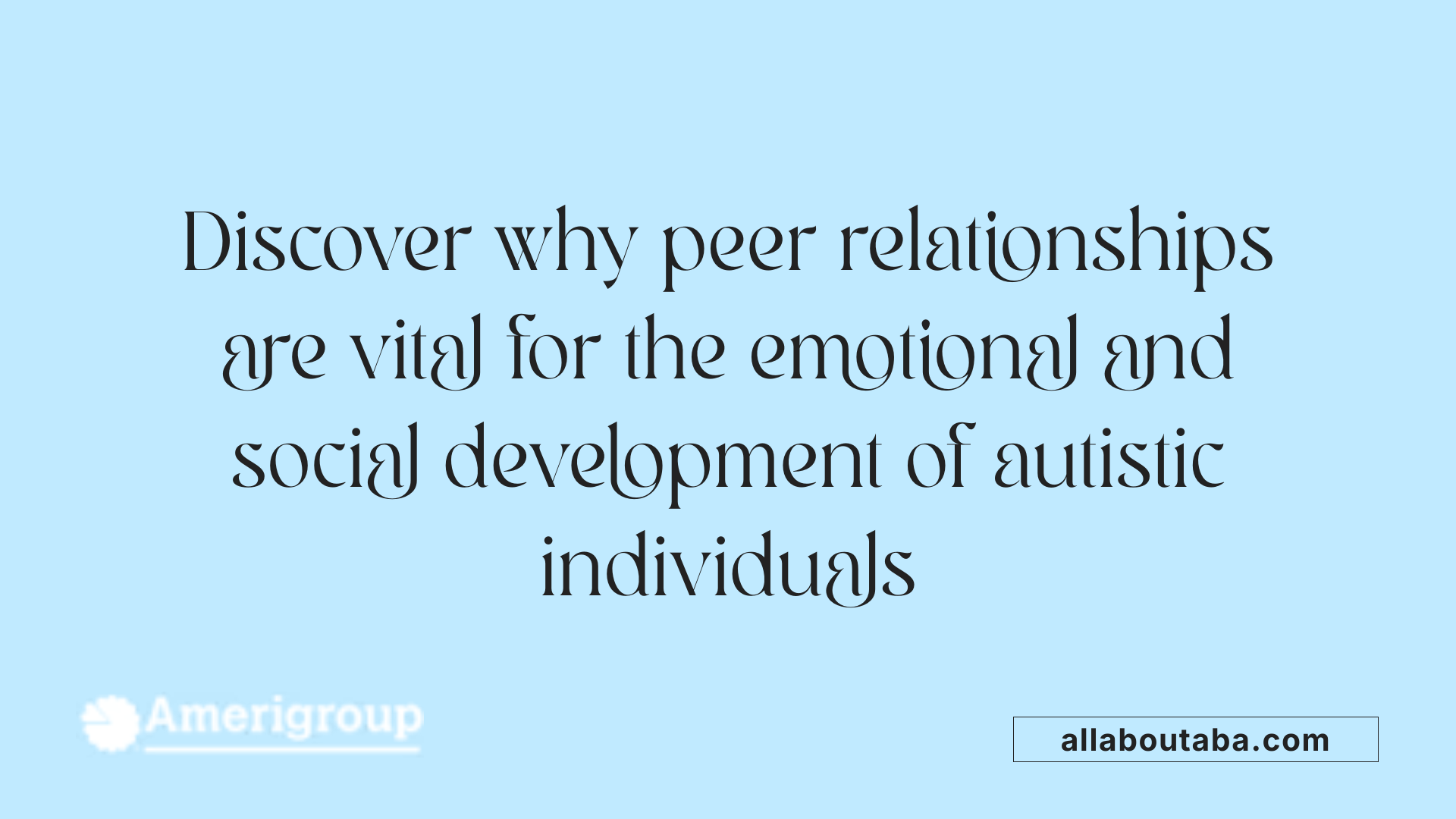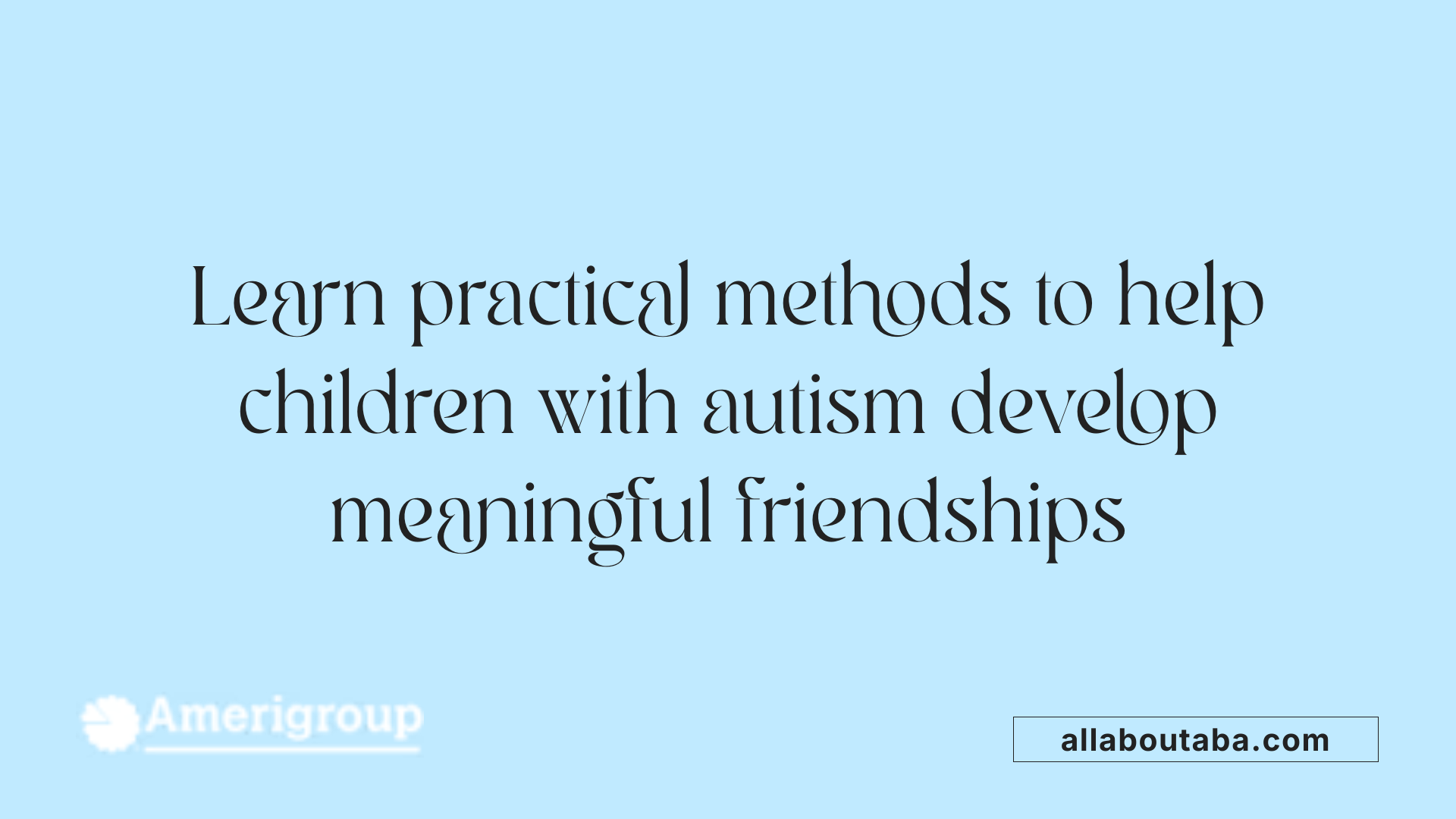Understanding Autism and Its Impact on Social Development
Autism spectrum disorder (ASD) presents unique challenges and opportunities in social development. While children with autism often desire peer interactions, difficulties in communication, sensory processing, and understanding social cues can hinder their ability to form meaningful relationships. Recognizing these complexities is vital for parents, educators, and caregivers working to create supportive environments that foster social growth and friendship building.
Diverse Forms of Peer Relationships and Their Characteristics

What types of peer relationships exist, and how are they characterized?
Peer relationships in childhood and adolescence take many forms, each playing a vital role in social and emotional growth. These include dyadic friendships, peer acceptance, cliques, and crowds.
Dyadic friendships are close one-on-one relationships marked by mutual support, sharing, and emotional connection. Children often choose friends based on shared interests or familiarity, which helps develop social skills and self-esteem.
Peer acceptance refers to how much an individual is liked and accepted by their peer group. High acceptance contributes to positive self-image and confidence, while rejection or marginalization can affect mental health.
Cliques are small, tight-knit groups comprising friends who spend a lot of time together, share common interests, and exert influence over each other. They foster a sense of belonging but can sometimes lead to social exclusion of others.
Crowds are larger social categories based more on stereotypes and social reputation, such as tagging students as
The Significance of Peer Connections for Autistic Individuals

Why are peer relationships important for individuals with autism?
Peer relationships hold exceptional value for children and adolescents with autism because they serve as a foundation for emotional support and social engagement. These relationships provide opportunities for practice and reinforcement of social skills in real-world settings, which can improve social competence overall. Despite the social difficulties often associated with autism, many individuals with ASD have a genuine desire to connect and form friendships.
Research shows that having meaningful peer interactions is linked to several positive outcomes. These include enhanced mental health, greater feelings of belonging, and a sense of acceptance. Building friendships can reduce loneliness and act as a buffer against emotional distress, promoting overall well-being.
Furthermore, peer relationships impact academic and social success. Opportunities such as group activities, collaborative projects, and shared interests foster social skills like turn-taking, sharing, and communication. These experiences not only aid in social development but also translate into better classroom engagement and learning.
Supportive environments—created through inclusive classroom settings, social skills programs, and community activities—are crucial in enabling children with autism to develop and sustain friendships. Educators, families, and peers can reinforce positive interactions by modeling behaviors, teaching social norms, and celebrating small successes.
In sum, fostering peer relationships is essential for the emotional health and overall development of individuals with autism. These connections help them navigate social worlds more confidently, leading to improved quality of life and a stronger sense of community.
Effective Strategies for Developing Social Skills

What are effective strategies to support social skill development in children with autism?
Supporting social skills in children with autism requires a multifaceted approach that respects their unique perspectives and abilities. One of the most effective methods is providing explicit instruction. This involves clearly teaching social behaviors, such as turn-taking, sharing, and understanding social cues, often through direct teaching and modeling.
Structured social activities serve as practical environments where children can practice social interactions safely and predictably. These activities include group games, collaborative projects, and creative tasks designed to promote sharing, communication, and teamwork. The structured nature of these activities helps children understand what is expected, reducing anxiety and increasing confidence.
Visual supports, like social stories, visual schedules, and cue cards, are instrumental in helping children anticipate routines, understand social expectations, and communicate more effectively. These tools are especially useful for children who process information visually and may struggle with verbal instructions.
In line with neurodiversity principles, it’s important to honor each child's natural communication style. Respecting autism as a variation rather than a disorder helps foster acceptance and reduces pressure to mask behaviors that might cause stress or diminish mental health. Supporting these principles means creating environments that celebrate differences and emphasize individual strengths.
Peer-mediated interventions involve pairing autistic children with supportive peers who can model appropriate social behaviors and facilitate interactions. This approach promotes naturalistic and reciprocal friendships, often leading to more meaningful social engagement and understanding.
Technology-based social skills training is increasingly prevalent and effective. Computer programs, social apps, and online platforms provide interactive opportunities for practicing social interactions in engaging ways. These tools are adaptable to individual needs and can supplement in-person training, enhancing social reciprocity and participation.
Overall, research shows that integrating these strategies—explicit instruction, structured activities, visual supports, neurodiversity affirming practices, peer involvement, and technology—can lead to significant improvements in social engagement, acceptance, and friendship formation. Recognizing and respecting individual differences remains central to fostering genuine and lasting social connections for children with autism.
Techniques to Foster Friendships and Peer Connections

What techniques can help children with autism develop friendships and peer connections?
Supporting friendship building skills in children with autism involves a variety of practical strategies. One effective approach is providing explicit instruction in social skills, such as initiating conversations, taking turns, and understanding social cues. Visual aids, social stories, and role-playing activities help make these skills clear and accessible.
Structured peer-mediated interventions are also valuable. Programs like social skills groups and buddy systems create guided opportunities for children to practice interactions with both autistic peers and their typically developing classmates. These settings offer a safe environment for learning and social engagement.
Teaching empathy and perspective-taking is another critical element. Using social narratives and recognizing emotional expressions help children understand how others feel, which can lead to more meaningful interactions. Reinforcing positive social behaviors, modeling appropriate actions, and celebrating individual strengths build confidence and encourage social participation.
Supporting sensory integration and emotional regulation is important. When children feel comfortable and are able to manage their emotions, they are more likely to engage successfully with peers. Overall, combining structured instruction with supportive environments promotes the development of friendships and more resilient peer connections.
How do visual aids and social stories assist in developing social skills?
Visual supports like charts, picture schedules, and social stories prepare children for social situations. They provide visual cues about expected behaviors and routines, reducing anxiety and misunderstandings.
Why is emotional regulation important in friendship development?
Managing emotions helps children respond appropriately to social cues and maintain positive interactions. Techniques such as recognizing feelings and calming strategies support smoother peer relationships.
How can strengths be celebrated to encourage social growth?
Focusing on a child's interests and talents boosts confidence and motivates participation in social activities, making friendship-building a more engaging and rewarding process.
What role does structured peer interaction play?
Organized activities like group games, team projects, and cooperative tasks provide concrete opportunities for children to practice sharing, communicating, and working together, which are essential for establishing and maintaining friendships.
| Technique | Focus Area | Benefit | Example Activities |
|---|---|---|---|
| Social Skills Training | Communication, initiating | Enhances basic interaction skills | Role-playing, social stories |
| Structured Peer Activities | Sharing, turn-taking | Builds confidence and social competence | Group games, collaborative projects |
| Empathy and Perspective-Taking | Emotional understanding | Promotes better peer understanding | Social narratives, watching videos |
| Celebrating Strengths | Self-esteem, motivation | Encourages engagement | Highlighting talents, rewarding efforts |
| Visual Aids & Social Stories | Routine, cues | Reduces anxiety, clarifies expectations | Picture schedules, scenario-based stories |
| Emotional Regulation | Stress management | Supports calm interactions | Recognizing feelings, breathing exercises |
Understanding Autism’s Impact on Peer Relationships
How does autism affect peer relationships?
Autism spectrum disorder (ASD) can present significant challenges in forming and maintaining friendships. Children with autism often experience difficulties in understanding social cues and engaging in reciprocal communication, which are essential for healthy peer relationships. They may struggle with turn-taking, sharing, or responding to social initiations, leading to potential misunderstandings and feelings of exclusion.
Behavioral differences, sensory sensitivities, and variations in play preferences can further hinder social interactions. These factors may cause children with autism to withdraw or be misunderstood by their peers, increasing the risk of loneliness and social isolation.
Early diagnosis and intervention are crucial. They help identify specific needs and foster development of social skills through targeted strategies such as social stories, role-playing, and visual supports.
Creating inclusive environments is equally important. Schools and community settings that provide structured activities—like group games, collaborative projects, and social groups—offer safe spaces for children with autism to practice social skills.
Support strategies, including peer pairing with confident classmates, educating peers about autism, and encouraging shared interests, can significantly improve peer acceptance. Practical interventions like visual aids, social narratives, and organized playdates help bridge social gaps.
Overall, with the right understanding and support, children with autism can build meaningful friendships, enhance their social competence, and enjoy richer peer interactions.
Addressing Challenges in Peer Relationship Formation

What challenges do autistic children face in forming peer relationships, and how can they be addressed?
Children with autism often encounter specific obstacles when trying to develop friendships and engage with peers. One significant challenge is difficulty understanding social cues such as facial expressions, body language, and tone of voice. These nonverbal signals are crucial for navigating social interactions and often lead to misunderstandings.
Communication barriers also play a major role. Autistic children might struggle with initiating conversations, responding appropriately, or maintaining ongoing dialogues. These difficulties can make it hard for them to connect and sustain friendships.
Sensory sensitivities add another layer of complexity. Overwhelming sensory stimuli, like loud noises or bright lights, can increase stress and reduce comfort in social settings. This may cause autistic children to withdraw from group activities or avoid social interactions altogether.
Furthermore, interpreting social norms and rules can be confusing. Many autistic children find it challenging to grasp unwritten social expectations, which can lead to social exclusion, rejection, or being misunderstood by peers.
Addressing these challenges requires a multifaceted approach:
- Social skills training: Structured activities that teach turn-taking, sharing, and empathy can enhance social competence.
- Creating inclusive environments: Schools and communities that recognize diverse social preferences promote acceptance and participation.
- Modeling respectful behavior: Educators, therapists, and peers can demonstrate appropriate social interactions, fostering understanding.
- Supporting self-advocacy: Teaching children to express their needs and feelings empowers them to navigate social situations better.
- Facilitating social opportunities: Arranging structured playdates and group activities in familiar settings helps autistic children practice social skills safely.
Fostering a supportive atmosphere—where differences are respected and individual strengths celebrated—is essential for helping autistic children form meaningful peer relationships. With appropriate support and understanding, many can develop lasting friendships that contribute positively to their social and emotional well-being.
Creating Inclusive and Supportive Social Environments
Fostering peer relationships in children with autism requires a comprehensive understanding of their social needs and tailored intervention strategies. It involves educating peers and adults alike about autism, implementing structured activities that promote social engagement, and fostering inclusive environments that celebrate individual differences. Such efforts can significantly enhance the social competence, emotional well-being, and overall quality of life for autistic individuals. Building a supportive community where autistic children feel accepted and understood not only benefits their social development but also enriches the social fabric of the entire educational and community environment.
References
- Autism and Social Skills Development
- Building Peer Connections: Autism Group Activities
- Supporting Peer Relationships and Friendships for School-Aged ...
- Helping the Autistic Child Build Peer Relationships and Friendships
- Autism to Peers: Educating Friends and Classmates | ABA Therapy
- Expert Q&A: Peer Relationships and Autism
- Friendship interventions and measurements in children with ASD
- Autism and Friendships: Building Connections - All Star ABA







